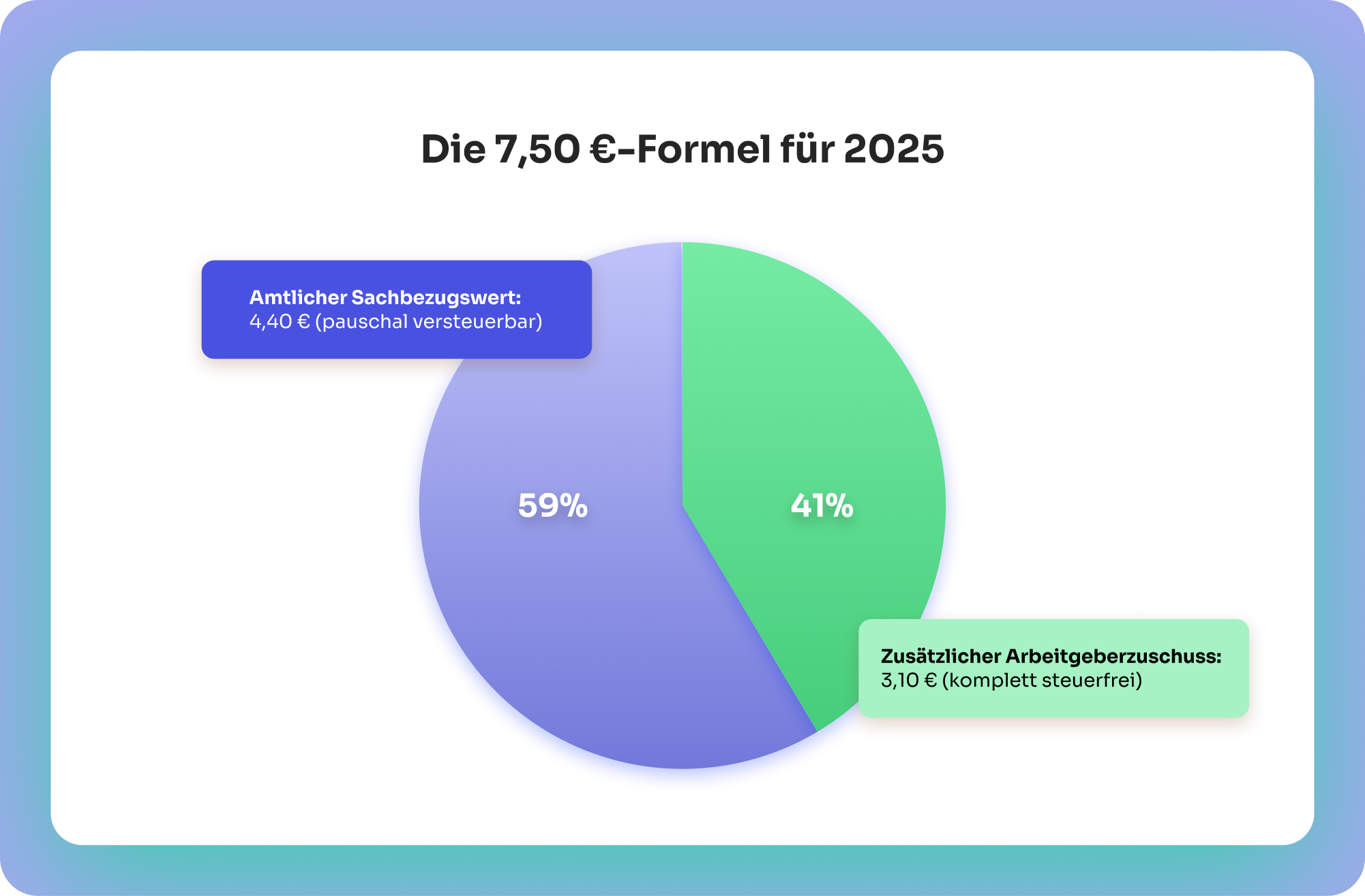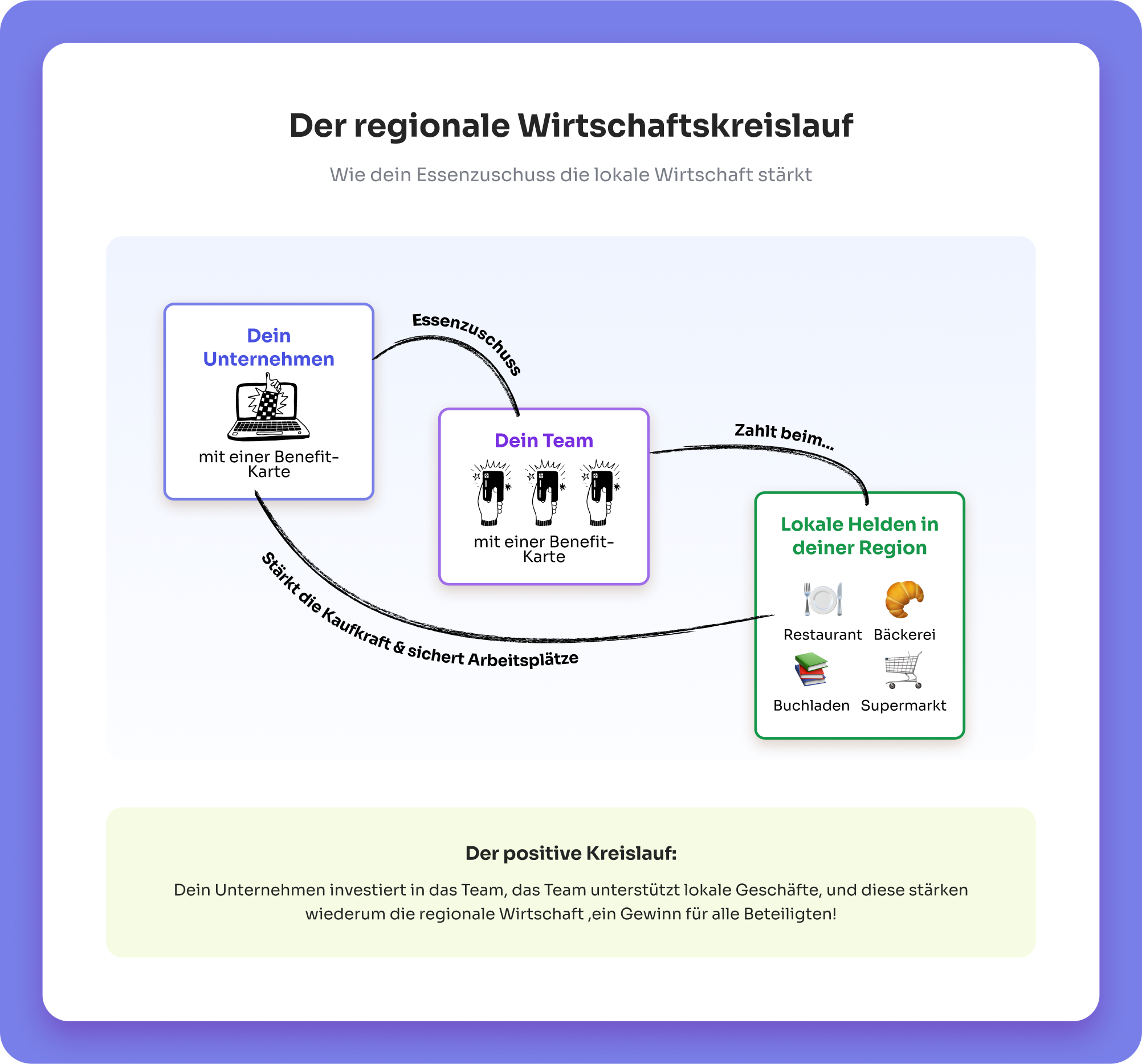

Tax-optimized canteen dinner: Benefits & regulations for companies
All information about tax-optimized canteen dinners ✓ Statutory principles ✓ Tax savings ✓ Implementation in business ✓ Practical tips ✓ Find out more now!

Tax-optimized canteen dinner 2025: Your ultimate guide for more net, motivated teams and a strong region
Are you looking for a way to show genuine appreciation to your team without breaking the bank? A benefit that arrives daily and has more effect than a one-off bonus? Then take a look at the lunch table. Because right here, in the daily food for your employees, lies dormant an untapped superpower: tax-optimized canteen food, better known as the digital meal allowance.
What is tax-optimized canteen dinner?
Tax-optimized canteen dinner is a state-sponsored meal subsidy that allows employers to grant their employees up to €7.50 per working day (as of 2025) for meals. This benefit is tax-free for employees and cheaper for companies than a salary increase.
This guide is your navigator through the world of tax benefits and modern employee benefits. We'll show you how to make maximum use of the legal regulations for 2025 to your advantage, how to turn your company into a top employer and — that's the highlight — how to not only strengthen your team with the right digital solution, but also become a hero for your local economy.
The 2025 meal subsidy — all figures, data and facts at a glance
Before we examine the strategic benefits, we create a solid foundation. The food subsidy is not rocket science, but a clearly defined and state-approved lever to relieve employees and employers.
The legal framework — your basis for success
The meal allowance is a voluntary additional benefit provided by your company and is not a legal claim for employees, unless it is enshrined in the employment or collective agreement. For tax purposes, it is regarded as a so-called “monetary advantage”, a benefit in kind that is granted in addition to the salary.
The special feature is that, under certain conditions, the legislator massively favours this monetary advantage for tax purposes. The legal basis for this is primarily found in the Income Tax Act (EStG), in particular in Section 8 (2), and in the Social Security Pay Ordinance (SvEV). The SvEV is adjusted annually to the development of consumer prices, which is why the decisive values — the so-called official benefits in kind — change regularly. For 2025, the Federal Council adopted the 15th ordinance amending the SvEV on November 22, 2024 and the Federal Ministry of Finance (BMF) specified the application in a letter dated December 10, 2024, which gives us planning security for the coming year.
The magic formula for 2025: This is how the €7.50 is made up
The maximum possible subsidy per employee and working day is a clever combination of two components. When you understand this formula, you understand the whole system.
- Component 1: The official benefit in kind. This is the amount that the state sets as a lump sum for a meal provided by the employer. For 2025, this value was set to €4.40 raised for lunch or dinner (2024: €4.13). This part of the subsidy is the taxable base.
- Component 2: The tax-free employer subsidy. In addition to the benefit in kind, as an employer, you can pay a further amount of up to €3.10 grant. This supplement is completely free of tax and social security contributions.
The result of this simple addition is: €4.40+€3.10 = €7.50. That's the maximum amount you can give your employee a meal per working day, with huge tax benefits.
Let's calculate the potential: Simplified billing of 15 working days per month results in a monthly advantage of up to 112.50€. Calculated over the entire year, this means a tax-free salary increase of up to 1.350€ per employee.
The 2025 meal subsidy in detail
This table gives you all relevant key figures at a glance and shows the positive development compared to the previous year.

Tax-free vs. lump sum taxation: The smart way to optimize your salary
Now it's going to be decisive. How do you ensure that the subsidy actually reaches the employee tax-free? There are two ways here, which depend on the employee's co-payment.
Scenario 1 (The ideal solution — completely tax-free):
The subsidy is completely free of tax and social security contributions for all parties involved — employer and employee — if a simple condition is met: The employee himself pays at least the amount of the official benefit in kind (i.e. 4.40€ in 2025) to his meal.
example: A meal costs €12. Your employee pays at least 4.40€ in their own contribution. As an employer, you can now subsidize the remaining €7.60, with your subsidy limited to a maximum of €7.50. In this case, your subsidy of €7.50 remains completely tax-free.
Scenario 2 (The flexible alternative — lump sum taxation):
What happens if the employee pays less than 4.40€ or the meal is cheaper? In this case, there is a taxable monetary advantage. But here too, the legislator has created an elegant solution: As an employer, you can pay this amount as a lump sum of just 25% income tax tax. The huge advantage of this is that there are no social security contributions under this lump sum tax. For employees, the subsidy therefore remains tax-free and duty-free.
Distinguishing between these two scenarios can quickly become complex in manual administration. For each employee and each individual document, it would be necessary to check how much the co-payment was in order to ensure correct tax treatment. This is an administrative effort that scares off many companies. But this is exactly where the strength of modern, digital systems lies: The best solution makes this complex decision for you and automatically ensures 100% legally compliant processing in the background.
The win-win effect: Why the meal allowance is worthwhile for everyone
The digital meal subsidy is much more than just tax optimization. It is a strategic tool that triggers a positive chain reaction in your company — a real win for you as an employer and for every single employee in your team.
For your company (The employer advantage)
Save costs — The direct comparison:
Perhaps the most convincing indicator for every entrepreneur is the cost savings compared to a classic salary increase. Since the meal allowance (ideally) has no or only very low non-wage costs, it is by far the most efficient way to give your team more net income.3 You save around 20-25% of employer social security shares.
Cost comparison — €100 pay increase vs. €100 meal allowance
This comparison shows how much more efficient the meal allowance is. The figures show why a salary increase often fizzles out while a payment in kind arrives 1:1.
Employer branding & employee retention:
In today's “War for Talents,” it is often the smart benefits that make the difference. A daily, noticeable subsidy for lunch is a strong signal of appreciation and positions you as a modern, caring employer. Happy employees remain loyal to the company and become the best ambassadors for your employer brand.
Motivation, Health & Productivity:
Good food is fuel for good work. By making it financially easier to access high-quality meals, you are actively promoting the health and well-being of your team. A well-nourished team is demonstrably more concentrated, more creative and more efficient. In addition, joint lunch breaks, which are supported by the subsidy, strengthen social cohesion and team building.
For your team (The employee advantage)
More net of gross:
This is the most direct and quickly noticeable benefit. Up to €1,350 more purchasing power per year, which is not eaten up by taxes and social security contributions, makes a real difference in your wallet.
Maximum flexibility in everyday life:
The days when employees were tied to a specific canteen or a handful of partner restaurants are gone. Modern digital food subsidies offer absolute freedom. Whether it's the favorite restaurant around the corner, the quick salad from the supermarket, the bakery for the midday snack or the delivery service to the home office — employees decide for themselves how and where they use their subsidy every day.
Respect in action: In contrast to an annual salary adjustment, the meal allowance is a benefit that is present daily. It is a constant, positive reminder of the employer's appreciation and relieves the private budget of one of the most regular everyday expenses.
Implementation in practice — From the old canteen to the digital future
The idea is compelling, but how do you bring the meal allowance to your company? The way the program is implemented is critical to the success and acceptance of the program.
The classic path and its limits
Traditionally, there were two options: your own company canteen or paper food stamps. Both have significant disadvantages today. A canteen involves high investment and operating costs and is unrealistic for most small and medium-sized companies. It is also inflexible and useless for employees working from home or in the field. Paper food stamps, on the other hand, cause enormous administrative costs: ordering, distributing, collecting, billing. They are environmentally harmful, can be lost and can usually only be redeemed by a limited number of acceptance partners.
The modern solution: digital systems as game changers
Digitalization has revolutionized the world of employee benefits. Modern, digital food subsidies solve the problems of old systems and offer a whole new level of simplicity and flexibility.
In the process, the technology itself has evolved. The first digital solutions were often just apps for issuing documents or systems that were linked to a closed partner network. That was a step forward, but the basic restrictions remained.
Today's gold standard and by far the most employee-friendly solution is an open system based on a prepaid debit card, such as a Mastercard. This model provides universal acceptance of a global payment network. Employees can use it to pay wherever card payments are possible — simply, quickly and without having to submit supporting documents.
What you should look for in a digital provider
When choosing a digital solution, pay attention to these key quality criteria:
Maximum acceptance:
Is the solution based on an open system such as a Mastercard or Visa? Only this guarantees maximum freedom for your team and prevents the frustration of rejected payments.
Automation & simplicity:
Is there a central HR portal where you can control everything with just a few clicks? Is the monthly recharge of the cards fully automatic?
Legal security & compliance:
Does the provider guarantee 100% correct compliance with all tax rules? Does the system ensure that the GoBD guidelines (principles for the proper management and storage of books, records and documents in electronic form as well as for data access) are complied with?
Flexibility for new working environments:
Can the solution be used seamlessly by employees in the office, working from home and in the field?
The “added value” factor:
Does the provider offer you the opportunity to make a positive contribution beyond pure benefit — for example by specifically strengthening the economy in your region?
The regional factor — How your food allowance becomes a local hero
Imagine that every euro you invest in your team has a double effect. It not only ends up as a salary increase for your employees, but also flows directly back into the community in which your company and employees live and work. That is exactly the idea behind a regionally oriented food subsidy.
The double effect: think globally, act locally
Instead of letting purchasing power flow to large, anonymous online retailers or international chains, you can bundle it in a targeted manner. With the right digital solution, you can determine that the subsidy can only be issued in a specific postal code area or a defined region. This makes every lunch served by your team a small investment in the bakery on the corner, the family-run restaurant and the local supermarket.
Demonstrate responsibility and create identity
This approach is corporate social responsibility (CSR) in practice. It is authentic, tangible and far more effective than an anonymous donation. You position your company as a responsible actor who is aware of its roots and actively contributes to the local quality of life. This not only strengthens your reputation in the community, but also helps your employees identify with their company and their home region.
“More net, more neighborhood”: The emotional component
This benefit takes on a completely new, emotional dimension. It is no longer just about money, but about “reviving your own neighborhood” and maintaining “diversity on your doorstep.” Your employees become active sponsors of their own neighborhood. This positive, meaningful charge creates a much deeper connection to the benefit and to you as an employer.

Frequently asked questions (FAQ) — Your quick path to clarity
Here we answer the most pressing questions on the topic — briefly, concisely and straight to the point.
Does the meal allowance also work when working from home?
Yes, absolutely. Digital meal subsidies are ideal for working from home. Employees can use it to order their lunch from the delivery service or buy ingredients from the supermarket. The only important thing is that you actually worked on that day and bought a meal.
What is the difference between additional food costs?
The meal allowance is intended for a normal working day. The additional food expenses (expenses) are a tax-free lump sum for business trips of 8 hours or more. Both services must be strictly separated and may not be combined for the same day.
What can and cannot be bought with the subsidy?
You can buy food that is intended for immediate consumption or to prepare a meal. Alcohol, tobacco and non-food items such as household goods are typically excluded. Bulk purchases in stock are also not permitted.
How complex is the introduction of a digital system?
Surprisingly easy. Modern providers often enable go-live within a few days. After a one-time setup in the HR portal, during which you create your employees and set the budget, the system usually runs fully automatically and without further technical effort.
As an employer, do I have to check the supporting documents?
With modern digital systems: No. In the case of pure reimbursement apps, the provider takes over the check. Advanced, card-based solutions completely eliminate the need for document verification for you as an employer. Legally compliant use is ensured by intelligent systems in the background, which massively simplifies your administration.
Conclusion: Make the difference — for your team and your region
The tax-optimized canteen dinner is much more than a clever way to save taxes. It is one of the most effective tools of modern personnel management. It's a chance to show your team that you value them every day, while maximizing the efficiency of your payroll costs.
Let's summarize the superpowers again:
- Financially smart: You save money on non-wage costs and at the same time give your team more net gross than with any salary increase.
- Humanly valuable: You increase motivation, satisfaction and loyalty through a benefit that really goes down in everyday life and makes the lives of your employees easier.
- Regionally strong: With the right solution, you can invest directly in your home country, strengthen the local economy and position your company as a responsible hero in the neighborhood.
Ready to unleash the super power during your lunch break? Don't wait any longer. Find the digital, flexible and regional solution today that will make your company and team real heroes.
List of sources

Everything you want to know — simply explained.
Everything you want to know — simply explained.
What is the benefit card?
The HERO Card is a digital Mastercard debit card that allows companies to offer tax-free benefits easily and flexibly. Employees thus receive tax-free subsidies for benefits in kind, mobility, food and health. Everything bundled on one card, individually configurable and implemented in a legally secure manner.
Employees simply pay on a daily basis. Locally in your favorite café or nationwide in supermarkets, pharmacies or public transport.
How does that work for companies?
You control everything centrally in the HR portal.
Activate benefits in five minutes. The HERO Card automatically loads the monthly budget. Digital, secure and tax-compliant.
What are the concrete benefits of this for my team?
Up to 50 euros in kind per month
Meal allowance of up to 7.50 euros per working day
Mobility allowance of up to 58 euros per month
Up to 500 euros per year for health and wellbeing
All tax-free. It's all digital. It's all on one card.
How does HR keep track?
All benefits at a glance. No paperwork.
In the HR portal, you control budgets, see workload and manage everything centrally.
Sign in. Adjust. It's done.
This saves you up to 80 percent of administrative time.
Is that really tax-free?
Yes, all benefits are tax-free for employees and are completely legally compliant. Employers must tax some benefits as a lump sum.
The HERO Card uses legally enshrined allowances. Each category is correctly separated for tax purposes and can be managed automatically.
How much does the HERO Card cost?
As part of the employee license, the card costs 1 euro per employee per month plus charges for charging benefits.
For 50 employees with HERO Base, for example, this equates to around 140 euros per month — less than a joint team meal, but with a long-term effect.
How quickly is the HERO Card ready for use?
Ready to go in just a few days.
Setup, onboarding and go-live take a maximum of one week.
No technical hurdles. Without complexity.




